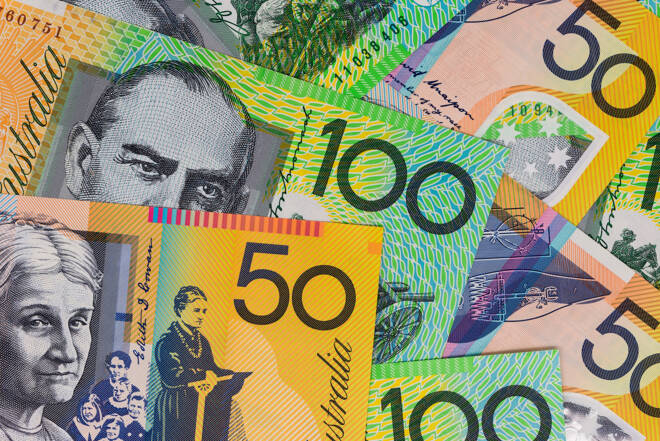Advertisement
Advertisement
AUD to USD Forecast: Australian CPI Indicator Falls from 5.6% to 4.9% in October
By:
The Australian CPI Indicator fell by more than expected in October. However, inflation remains sticky, supporting a hawkish RBA rate path.
Highlights
- The AUD/USD rallied 0.63% on Tuesday, ending the session at $0.66479.
- Dovish Fed comments and US economic data contributed to the gains on Tuesday.
- On Wednesday, Australian inflation figures delivered early direction.
Tuesday Overview of the AUD/USD
The AUD/USD rallied 0.63% on Tuesday. Following a 0.41% gain on Monday, the Aussie dollar ended the day at $0.66479. The Aussie dollar dropped to a low of $0.65963 before reaching a high of $0.66658.
Australian Inflation in the Spotlight
On Wednesday, Australian inflation numbers for October garnered investor interest. In November, the RBA hiked rates in response to an uptick in inflation and wage growth.
In October, the CPI Monthly Indicator declined from 5.6% to 4.90%. Economists forecast a fall to 5.2%.
According to the ABS,
- Housing (+6.1%), food and non-alcoholic beverages (+5.3%), and transport (+5.9%) reported the most marked price increases.
- Excluding volatile items and holiday travel, the annual inflation rate softened from 5.5% to 5.1%.
- Electricity prices increased by 10.1% in the 12 months to October 2023, down from 18.0% in September. In October, electricity prices increased by 3.4%.
- Automotive fuel prices increased 8.6% in the 12 months to October versus 19.7% in September.
RBA Implications
The inflation figures supported market bets on the RBA holding rates unchanged in 2024. Softer-than-expected numbers likely removed the need for further rate hikes after weaker-than-expected retail sales figures on Tuesday.
On Tuesday, RBA Governor Michele Bullock reiterated the need for restrictive policy to tame inflation. Sticky inflation would support bets on the RBA rate path for 2024.
Other economic indicators include construction work done numbers for Q3. However, the CPI report was the focal point.
In response to the numbers, the Aussie dollar slid from $0.66509 to a low of $0.66370 before recovering.
US GDP and the Fed in Focus
On Wednesday, the spotlight will be on the Q3 US GDP numbers. According to first estimates, the US economy showed robust growth of 4.9%. However, investors must consider revisions to the first estimate numbers.
Beyond the headline number, the components need consideration. Real disposable income and savings are focal points for investors assessing the economic outlook. A more marked decline in real disposable income and savings could have adverse implications for consumer spending.
Negative trends in consumer spending could ease demand-driven inflation and the need for a hawkish Fed rate trajectory. Additionally, an impact on consumer spending could adversely affect the US economy and fuel fears of a hard landing. US private consumption contributes over 60% to the US economy.
Apart from the numbers, Fed speakers will remain a focal point, with Loretta Mester on the calendar to speak. Any references to inflation trends and interest rates will draw investor interest.
Short-Term Forecast
Near-term AUD/USD trends will hinge on US inflation numbers. Softer-than-expected US inflation figures would support bets on an H1 2024 Fed rate cut. In contrast, the markets are betting on the RBA leaving rates unchanged in 2024. Inflation dynamics tilt policy divergence toward the Aussie dollar.
AUD/USD Price Action
Daily Chart
The AUD/USD held above the 50-day and 200-day EMAs. The EMAs sent bullish price signals despite the AUD/USD sitting in overbought territory.
An AUD/USD return to $0.67 would support a move to the $0.67286 resistance level.
After the CPI report, Beijing, US GDP, and Fed commentary are focal points on Wednesday.
A fall through the $0.66162 support level would give the bears a run at the trend line and the 200-day EMA.
A 14-period Daily RSI reading of 70.35 shows the AUD/USD in overbought territory (typically above 70 on the RSI scale). Selling pressure could intensify at $0.66600.
4-Hourly Chart
The AUD/USD held above the 50-day and 200-day EMAs. The EMAs reaffirmed bullish price signals.
An AUD/USD move through the Tuesday high of $0.66658 would give the bulls a run at the $0.67286 resistance level.
However, a break below the $0.66162 support level would bring the trend line and the 200-day EMA into play.
The 14-period 4-Hourly RSI at 76.20 shows the AUD/USD in overbought territory. Selling pressure could intensify at the Tuesday high of $0.66658.
About the Author
Bob Masonauthor
With over 28 years of experience in the financial industry, Bob has worked with various global rating agencies and multinational banks. Currently he is covering currencies, commodities, alternative asset classes and global equities, focusing mostly on European and Asian markets.
Latest news and analysis
Advertisement
